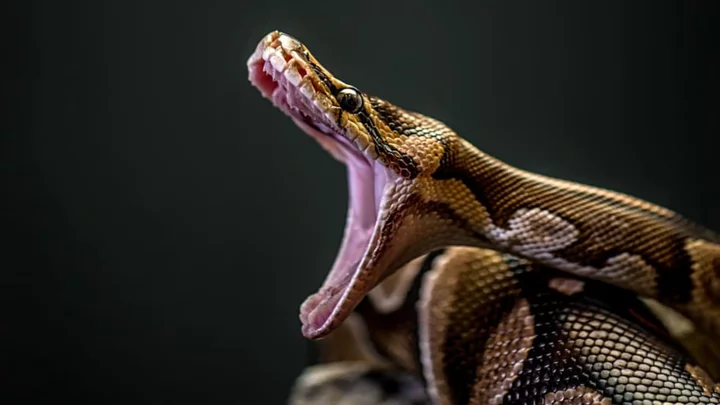Florida is perfect for invasive species. With more than 35 international ports of entry, nearly 120 million annual tourists, a thriving market for exotic captive wildlife, and mild winters, it’s no wonder the state appeals to humans and animals alike. More than 500 species have invaded Florida; here are nine of the most memorable animals.
1. Peacocks
Peacocks might be eye-catching, but they can be terrible neighbors. Native to Southeast Asia, they were brought to Florida as exotic pets (the Tampa colony seems to originate from a 1930s tourist attraction). The birds quickly adapted to life in the suburbs. By 2022, the population was out of control in Miami-Dade County: The wild peafowl scratched cars, pooped everywhere, and shrieked loudly during the mating season.
Because many residents originally liked the peacocks, Miami-Dade County passed a law in 2001 forbidding residents from killing them. But even when the law was repealed in 2022, residents were unwilling to euthanize the birds. The southern Miami town of Pinecrest came up with a creative solution: a $7500 monthly budget for peacock vasectomies. If successful, the program could be a blueprint for further peacock population control efforts in Florida.
2. Lionhead Rabbits
Lionhead rabbits, named for their fluffy manes, quickly took over the Fort Lauderdale community of Jenada Isles. After a backyard breeder illegally released them, they multiplied like, well, rabbits, and now number between 60 and 100. To the town’s dismay, the bunnies chew on outdoor wiring, dig holes in gardens, and leave droppings everywhere.
Like the peacocks, the townspeople are unwilling to euthanize the bunnies. Local resident Alicia Griggs is fundraising $20,000 to $40,000 to capture, neuter, vaccinate, shelter, and rehome the rabbits. After all, they were originally intended as pets and should have a chance to experience indoor life.
3. Capybaras
The world’s largest rodent was first reported in Florida in 1990, but their numbers increased in 1994 when five capybaras escaped from a wildlife sanctuary. The South American rodents can have up to eight young every year. Although all five escapees were recaptured, 38 additional capybaras were removed from the area between 1994 and 2003
Today, the Florida Fish and Wildlife Conservation Commission considers the capybaras an established species; there could be as many as 50 living in the state. But the rodents are elusive, and little is known about the colony or their future as a potential invasive species. All capybara sightings should be reported to local authorities or Florida Fish and Wildlife.
4. Vervet Monkeys
Catching a flight at the Fort Lauderdale-Hollywood International Airport might include spotting some West African vervet monkeys. The monkeys have lived in the 1500-acre mangrove forest near the airport ever since some escaped from a facility that imported primates for biomedical research in the 1940s.
A 2020 census indicated there were 40 of them, a population that has remained remarkably stable. Their main threats are a lack of genetic diversity and poaching for the pet trade. Florida normally attempts to remove invasive species, but the state tolerates the vervet monkeys because their range is limited. Tourists and employees are often delighted to see them at the Hertz or Park ‘N Fly parking lots. The city passed an ordinance prohibiting people from feeding the monkeys, but it’s not regularly enforced.
5. Nile Crocodiles
Florida is the only place where crocodiles and alligators live in the same area in the wild. While endangered the American crocodiles are native to the area, their larger African counterparts—the Nile crocodiles—are not. They’re also a lot more dangerous to people.
There is currently no evidence of an established Nile crocodile population, but the reptiles certainly feel at home in the Everglades. The first known Nile crocodile to run wild in Florida escaped from the Billie Swamp Safari in the late ‘90s; a fence was put up around the perimeter in the area and the croc was rediscovered in 2000. Three more were found between 2009 and 2014, one of which was marked, released, and recaptured according to the permit guidelines in Everglades National Park a year later [PDF]. Those Nile crocodiles aren’t a DNA match for the ones living in Disney’s Animal Kingdom, so it’s uncertain where the animals came from. Two of the three are related to each other.
6. Giant African Land Snails
The giant African land snail has repeatedly terrorized Florida. The gastropods—one of the most damaging snails in the world—lay about 1200 eggs a year, consume at least 500 different species of agricultural plants, and will gladly eat the stucco or paint off a house. If that weren’t bad enough, they can also transmit parasitic meningitis.
Florida first battled the snails in 1966, when a child smuggled two into downtown Miami after a trip to Hawaii. They were declared eradicated in 1975, after more than 18,000 snails and thousands of eggs were destroyed. The eradication program cost $1 million (approximately $3 million in today’s dollars).
In 2011, a practitioner of an African religion re-introduced the snails for a healing ceremony. Ten years, over 168,000 snails, and $23 million later, they were once again declared eradicated—only to reappear in 2022 and 2023. All giant African land snails should be reported to the Florida Department of Agriculture and Consumer Services for immediate collection [PDF].
7. Rhesus Macaques
In the 1930s, a glass-bottom boat operator known as Colonel Tooey released six rhesus macaques on an island in the Silver River for his jungle cruise attraction. The monkeys, though native to Asia, quickly settled in the surrounding forest, where they became a favorite with tourists, prompting the owner the park to release six more monkeys around 1948. Today, there are an estimated 200 rhesus macaques in and around Silver Springs State Park. The population is still growing.
The macaques made headlines in 2019 when they tested positive for Herpes B, also known as Monkey B virus. Primates experience mild or no symptoms, but for humans, the virus can be deadly. Around 18 incidents of rhesus macaque bites or scratches have been reported in Florida. Fortunately, there are no confirmed cases of a human contracting herpes B as a result. Florida Fish and Wildlife requests the public refrain from approaching or feeding the macaques to avoid infection.
8. Lionfish
Lionfish, with their ability to seemingly live everywhere and eat anything, are an invasive species that pose a serious threat to Florida’s reefs. These striped fish have 18 venomous spines, making them unpopular with predators and painful for humans. And with females releasing 12,000 to 15,000 eggs as often as every four days, they were primed for population explosion that finally hit in the mid-2000s.
Lionfish were first reported in 1985, but rumored sightings had been circulating since the ’70s. Native to the Pacific Ocean, scientists believe they were introduced to Florida by home aquariums emptied into the ocean (a theory backed up by the invader’s lack of genetic diversity). The number of lionfish in the Gulf of Mexico isn’t known, but just one can reduce the recruitment—the process when young fish transition into older, bigger fish—of native reef fish by 79 percent.
Florida has started holding Lionfish Roundups, where spearfish divers compete to collect the most fish. This year’s Emerald Coast Open Tournament eliminated 24,699 lionfish, dwarfing last year’s 13,835. The popular event brings some much-needed fun to invasive species removal.
9. Burmese Pythons
Burmese pythons are potentially the most damaging invasive species in Florida today. Between 1997 and 2012, marsh rabbits, cottontail rabbits, and foxes effectively disappeared from the southern Everglades while the number of raccoons dropped 99.3 percent, opossums 98.9 percent, and bobcats 87.5 percent. Scientists often find these animals in the stomachs of removed pythons.
Native to Southeast Asia, the Burmese python was first brought to Florida in the 1980s as part of the pet trade. Females are capable of producing 50 to 100 eggs every year. The exact number of Burmese pythons slithering around Florida is unknown because the snakes are notoriously elusive and have incredibly effective camouflage. Humans can only see them about 1 percent of the time.
In 2017, the Florida Fish and Wildlife Commission started a Python Elimination Program, which has removed more than 4000 of them; a similar initiative from South Florida Water Management got more than 8000. Technology like radio tags and snake-detecting computer algorithms will hopefully boost the removal programs and allow native mammals to return.
This article was originally published on www.mentalfloss.com as 9 Animals That Have Invaded Florida .









